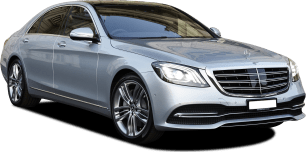Right now, only two S-Class models are available – the S450 from $240,700 plus on-road costs and the 110mm extended-wheelbase S450L (LWB) for another $24,900 on top. Most buyers overwhelmingly opt for the latter.
Despite what the numbers may suggest, both are powered by a 3.0-litre in-line six-cylinder turbo petrol engine, delivering 270kW of power and 500Nm of torque to all four wheels via a nine-speed torque-converter automatic. Greater choices are coming later, including an all-electric version known as the EQS.
Almost every conceivable safety item is standard on the S-Class, including world-first rear-seat airbags located behind the front seats in the LWB model, taking the surround-airbag count to 10.
You'll also find route-based Speed Adaptation (adhering to the posted speed limits), Evasive Steering Assist (a sophisticated form of crash mitigation), adaptive cruise control with active stop/go, Active Lane Change Assist that automatically moves the car into the lane you indicate to), Mercedes' PreSafe crash-preparation tech that primes all the safety systems for impact, electronic stability program that encapsulates all the active driver-assist tech, Active Emergency Stop Assist, Autonomous Emergency Braking front and rear (including for cyclists and pedestrians), Traffic Sign Assist, Parking Package with Active Parking Assist and 360-degree camera and tyre pressure monitors.
On the equipment front there is the latest iteration of Mercedes' MBUX multimedia system with (another) world-first 3D display, complementing an OLED central display, powered closing doors, leather upholstery, air suspension, leather upholstery, velour floor mats, a multi-beam LED headlight system with adaptive high beams, heated and folding exterior mirrors, heat and noise-insulating acoustic glass for front side windows, dark privacy glass for rear windows, sunroof, roller sunblinds for rear windows, metallic paint and 20-inch AMG alloy wheels on runflat tyres.
Want cutting-edge multimedia? There's MBUX II's augmented reality for navigation and fingerprint scanner, as well as a more natural-speech Mercedes-Me Connect voice activation with global search.
Plus, predictive navigation with live traffic, parked vehicle locator, vehicle tracking, emergency call, maintenance management and tele-diagnostics, digital radio, Burmester 3D surround-sound system with 15 speakers and 710W amplifier, remote door locking/unlocking, geofencing, speed-fencing, valet parking, head-up display, Smart Phone integration with Apple CarPlay/Android Auto, wireless charging, ambient lighting, two-zone climate control, poplar wood trim, electric adjustment for front seats, steering column with memory function, climatised front seats, keyless entry/go with flush-fitting door handles offering hands-free access (including for the electric boot),
Besides the ‘forward facing' airbag for the rear-seat occupants, the S450L also scores electrically adjustable rear seats with memory and automatic rear climate control.
Key options – and the list is massive – include an $8700 Rear Entertainment Package, that brings rear-multimedia access, rear tablets with wireless headsets and rear-seat wireless smart phone charging, an AMG Line pack with a body kit, different alloys and larger front brakes ($6500), Business Class Package that includes aircraft-style reclining rear seating and tray tables ($14,500), Nappa leather ($5000), augmented-reality HUD ($2900), 21-inch wheels ($2000) and four-wheel steering ($2700). There's also a $14,500 Energising Package with contoured seating, heated-everything and massaging seats.
Please keep in mind our test cars featured many such extras. Tick all the boxes and you can add nearly $100,000 to the price of your S-Class.
So, is the S450 good value? Given some of the breakthrough safety and luxury features it offers, it is unique. Too bad the Federal Government's Luxury Car Tax makes them so much more expensive than they need to be.

